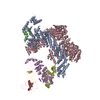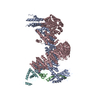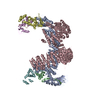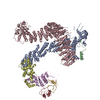+Search query
-Structure paper
| Title | Structural and mechanistic insights into the CAND1-mediated SCF substrate receptor exchange. |
|---|---|
| Journal, issue, pages | Mol Cell, Vol. 83, Issue 13, Page 2332-22346.e8, Year 2023 |
| Publish date | Jul 6, 2023 |
 Authors Authors | Mohammed Shaaban / Julie A Clapperton / Shan Ding / Simone Kunzelmann / Märt-Erik Mäeots / Sarah L Maslen / J Mark Skehel / Radoslav I Enchev /  |
| PubMed Abstract | Modular SCF (SKP1-CUL1-Fbox) ubiquitin E3 ligases orchestrate multiple cellular pathways in eukaryotes. Their variable SKP1-Fbox substrate receptor (SR) modules enable regulated substrate recruitment ...Modular SCF (SKP1-CUL1-Fbox) ubiquitin E3 ligases orchestrate multiple cellular pathways in eukaryotes. Their variable SKP1-Fbox substrate receptor (SR) modules enable regulated substrate recruitment and subsequent proteasomal degradation. CAND proteins are essential for the efficient and timely exchange of SRs. To gain structural understanding of the underlying molecular mechanism, we reconstituted a human CAND1-driven exchange reaction of substrate-bound SCF alongside its co-E3 ligase DCNL1 and visualized it by cryo-EM. We describe high-resolution structural intermediates, including a ternary CAND1-SCF complex, as well as conformational and compositional intermediates representing SR- or CAND1-dissociation. We describe in molecular detail how CAND1-induced conformational changes in CUL1/RBX1 provide an optimized DCNL1-binding site and reveal an unexpected dual role for DCNL1 in CAND1-SCF dynamics. Moreover, a partially dissociated CAND1-SCF conformation accommodates cullin neddylation, leading to CAND1 displacement. Our structural findings, together with functional biochemical assays, help formulate a detailed model for CAND-SCF regulation. |
 External links External links |  Mol Cell / Mol Cell /  PubMed:37339624 PubMed:37339624 |
| Methods | EM (single particle) |
| Resolution | 2.9 - 8.3 Å |
| Structure data | EMDB-17114, PDB-8or0: EMDB-17115, PDB-8or2: EMDB-17116, PDB-8or3: EMDB-17117, PDB-8or4:  EMDB-17124: CAND1-CUL1-RBX1 |
| Chemicals |  ChemComp-ZN: |
| Source |
|
 Keywords Keywords | LIGASE / CAND1 / substrate receptor exchange factor / cullin-RING ligase / CRL / SCF / neddylation / DCNL1 co-E3 / ubiquitin signaling |
 Movie
Movie Controller
Controller Structure viewers
Structure viewers About Yorodumi Papers
About Yorodumi Papers











 homo sapiens (human)
homo sapiens (human)